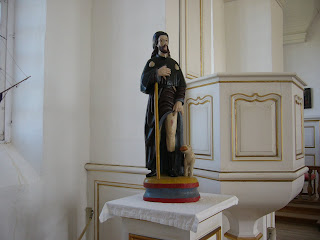
From its 18th-century (1700s) foundations, the whole--actually 1/5 of it--fortress was reconstructed in the 1900s. It was amazing to realise that this was the product of geopolitical horse trading among the European powers at various treaties thousands of kilometres away, at Utrecht, Aix la Chappelle, Spain, etc., and the inhabitants didn't have much to do with the existence of the place.

It's always the guide that makes or breaks any tour, and this was no exception. In this picture, she's showing how 18th-century would look out for men with nice calves in a "well-turned heel" of the plié position.

The fortress (which includes civilian elements, as opposed to a solely military fort) was named in honour of King Louis XV (the Fifteenth) of France.

Lacemaking was a skill women of nobility engaged in. It's been replaced by machine work since the Industrial Revolution. In Louisbourg, women were far outnumbered by men and had their pick of a husband. The main trade, in fact the raison d'etre, of the fortress was cod export, and everything else had to be imported--from France, the French West Indies, or Quebec.

This unidentified statue of a guy with a wound in his thigh might have been the patron saint of Louisbourg. Could it have been St Roch or St Louis IX? Who knows (not a rhetorical question!)? Apparently, this town didn't have enough time or interest to build a cathedral, and this tiny chapel was staffed with a priest and a few nuns. Together with the statue, other visual clues, such as a confessional booth, rosaries, and a statue of the Madonna, reminded soldiers that they didn't have direct access to God, under the teachings of their religion.
Here come the soldiers to the military demonstration of firepower:
Full of sound and fury, signifying nothing in the face of the British forces:

Another demonstration was the punishment of a thief convicted of stealing wine. Here he is, about to the chained to an iron collar in public. In the background, the seafood industry languishes in the modern town of Louisbourg, and the flag--white for surrender--still flies as a really grim comment on the economy of the whole area.

Before leaving the fortress grounds, we went to visit the Wolfe Redoubt (say "READ-out"), a temporary fort built by British General Wolfe, who garnered greater fame later on the Plains of Abraham. The guide had explained that from this vantage, the British were able to neutralise the French resistance at Louisbourg, leading to its surrender.

Two Wolfe wannabies at the Redoubt--unfortunately, the view of the fortress has been completely blocked by vegetation today.

Back at the campsite, while looking for a Chinese restaurant, I turned my car into a vertical car park barrier, resulting in a literal fender bender. With some trusty duct tape (a must for camping trips!), we were able to patch things back--at least for the next leg of our trip, to Halifax. Pity, no video, but I hope to get you a pic of the patch job later.
UPDATE: Here's the "After" picture:

Not bad, eh?





No comments:
Post a Comment